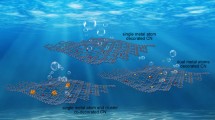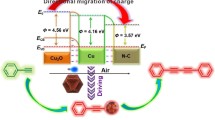Abstract
Nitrogen (N) and phosphorus (P) co-doped anatase TiO2 nanosheets were realized by low-temperature self-doping N–TiO2 followed by high-temperature P doping with foreign precursor. It is found that P doping process can maintain good TiO2 nanosheets morphology with exposed {001} facets. Chemical state of dopants indicates that N and P atoms replace O on O sites in TiO2 lattice. Compared with pure TiO2 and N-doped TiO2, N–P co-doped TiO2 nanosheets exhibits stronger optical absorption and higher degradation rate of dye molecules in visible light regime. The enhanced photocatalytic properties are attributed to two factors. On one hand, N–P co-doping can effectively reduce band gap of TiO2 from 3.20 to 2.48 eV, leading to an enhancement of the absorption in visible light regime. On the other hand, the presence of exposed {001} facets of TiO2 nanosheets can induce the effective separation of photogenerated electrons and holes in reaction.






Similar content being viewed by others
References
Fujishima A, Honda K. Electrochemical photolysis of water at a semiconductor electrode. Nature. 1972;238:37.
Legrini O, Oliveros E, Braun AM. Photochemical processes for water treatment. Chem Rev. 1993;93(2):671.
Zhou W, Li W, Wang JQ, Qu Y, Yang Y, Xie Y, Zhang KF, Wang L, Fu HG, Zhao DY. Ordered mesoporous black TiO2 as highly efficient hydrogen evolution photocatalyst. J Am Chem Soc. 2014;136(26):9280.
Ohno T, Lee SY, Yang Y. Fabrication of morphology-controlled TiO2 photocatalyst nanoparticles and improvement of photocatalytic activities by modification of Fe compounds. Rare Met. 2015;34(5):291.
Xiang QJ, Yu JG, Wang WG, Jaroniec M. Nitrogen self-doped nanosized TiO2 sheets with exposed 001 facets for enhanced visible-light photocatalytic activity. Chem Commun. 2011;47(24):6906.
Iwase M, Yamada M, Kurisaki T, Prieto-Mahaney OO, Ohtani B, Wakita H. Visible-light photocatalysis with phosphorus-doped titanium(IV) oxide particles prepared using a phosphide compound. Appl Catal B. 2013;132:39.
Gopal NO, Lo HH, Ke TF, Lee CH, Chou CC, Wu JD, Sheu SC, Ke SC. Visible light active phosphorus-doped TiO2 nanoparticles: an EPR evidence for the enhanced charge separation. J Phys Chem C. 2012;116(30):16191.
Ao YH, Xu JJ, Fu DG, Yuan CW. A simple method to prepare N-doped titania hollow spheres with high photocatalytic activity under visible light. J Hazard Mater. 2009;167(1):413.
Liu H, Chen YJ, Tian GH, Ren ZY, Tian CG, Fu HG. Visible-light-induced self-cleaning property of Bi2Ti2O7–TiO2 composite nanowire arrays. Langmuir. 2015;31(21):5962.
Akple MS, Low JX, Qin ZY, Wageh S, Al-Ghamdi AA, Yu JG, Liu SW. Nitrogen-doped TiO2 microsheets with enhanced visible light photocatalytic activity for CO2 reduction. Chin J Catal. 2015;36(12):2127.
Shao GS, Wang FY, Ren TZ, Liu YP, Yuan ZY. Hierarchical mesoporous phosphorus and nitrogen doped titania materials: synthesis, characterization and visible-light photocatalytic activity. Appl Catal B. 2009;92(1):61.
Lin L, Zheng RY, Xie JL, Zhu YX, Xie YC. Synthesis and characterization of phosphor and nitrogen co-doped titania. Appl Catal B. 2007;76(1):196.
Wu ZB, Dong F, Zhao WR, Guo S. Visible light induced electron transfer process over nitrogen doped TiO2 nanocrystals prepared by oxidation of titanium nitride. J Hazard Mater. 2008;157(1):57.
Wu XY, Yin S, Dong Q, Guo CS, Kimura T, Matsushita JI, Sato T. Photocatalytic properties of Nd and C co-doped TiO2 with the whole range of visible light absorption. J Phys Chem C. 2013;117(16):8345.
Ren CJ, Wang GP, Chen YC, Chen YQ. Degradation of benzene on Zr-doped TiO2 photocatalysts with a bimodal pore size distribution. Rare Met. 2014;33(6):714.
Cronemeyer DC. Infrared absorption of reduced rutile TiO2 single crystals. Phys Rev. 1959;113(5):1222.
Wang W, Ni YR, Lu CH, Xu ZZ. Hydrogenation temperature related inner structures and visible-light-driven photocatalysis of N–F co-doped TiO2 nanosheets. Appl Surf Sci. 2014;290:125.
Zhou P, Wu JH, Yu WL, Zhao GH, Fang GJ, Gao SW. Vectorial doping-promoting charge transfer in anatase TiO2 001 surface. Appl Surf Sci. 2014;319:167.
Gai YQ, Li JB, Li SS, Xia JB, Wei SH. Design of narrow-gap TiO2: a passivated codoping approach for enhanced photoelectrochemical activity. Phys Rev Lett. 2009;102(3):036402.
Zhu WG, Qiu XF, Iancu V, Chen XQ, Pan H, Wang W, Dimitrijevic NM, Rajh T, Meyer HW, Paranthaman MP, Stocks GM, Weitering HH, Gu BH, Eres G, Zhang ZY. Band gap narrowing of titanium oxide semiconductors by noncompensated anion-cation codoping for enhanced visible-light photoactivity. Phys Rev Lett. 2009;103(22):226401.
Wang P, Liu ZR, Lin F, Zhou G, Wu J, Duan WH, Gu BL, Zhang SB. Optimizing photoelectrochemical properties of TiO2 by chemical codoping. Phys Rev B. 2010;82(19):193103.
Meng N, Michael KH, Leung D, Leung YC, Sumathy K. A review and recent developments in photocatalytic water-splitting using TiO2 for hydrogen production. Renew Sust Energy Rev. 2007;11(3):401.
Choi WY, Termin A, Hoffmann MR. The role of metal ion dopants in quantum-sized TiO2: correlation between photoreactivity and charge carrier recombination dynamics. J Phys Chem. 1994;98(51):13669.
Long R, English NJ. New insights into the band-gap narrowing of (N, P)-co-doped TiO2 from hybrid density functional theory calculations. ChemPhysChem. 2011;12(14):2604.
Wang F, Sun YY, Hatch JB, Xing H, Zhu XC, Zhang HW, Xu XH, Luo H, Perera S, Zhang SB, Zeng H. Realizing chemical codoping in TiO2. Phys Chem Chem Phys. 2015;17(27):17989.
Park JH, Kim S, Bard AJ. Novel carbon-doped TiO2 nanotube arrays with high aspect ratios for efficient solar water splitting. Nano Lett. 2006;6(1):24.
Diebold U. The surface science of titanium dioxide. Surf Sci Rep. 2003;48(5):53.
Ohno T, Sarukawa K, Matsumura M. Crystal faces of rutile and anatase TiO2 particles and their roles in photocatalytic reactions. N J Chem. 2002;26(9):1167.
Murakami N, Kurihara Y, Tsubota T, Ohno T. Shape-controlled anatase titanium(IV) oxide particles prepared by hydrothermal treatment of peroxo titanic acid in the presence of polyvinyl alcohol. J Phys Chem C. 2009;113(8):3062.
Gong XQ, Selloni A. Reactivity of anatase TiO2 nanoparticles: the role of the minority (001) surface. J Phys Chem B. 2005;109(42):19560.
Yang HG, Sun CH, Qiao SZ, Zou J, Liu G, Smith SC, Cheng HM, Lu GQ. Anatase TiO2 single crystals with a large percentage of reactive facets. Nature. 2008;453(7159):638.
Yang HG, Liu G, Qiao SZ, Sun CH, Jin YG, Smith SC, Zou J, Cheng HM. Lu GQ(Max). Solvothermal synthesis and photoreactivity of anatase TiO2 nanosheets with dominant 001 facets. J Am Chem Soc. 2009;131(11):4078.
Asahi R, Morikawa T, Ohwaki T, Aoki K, Taga Y. Visible-light photocatalysis in nitrogen-doped titanium oxides. Science. 2001;293(5528):269.
Devi LG, Murthy BN. Characterization of Mo doped TiO2 and its enhanced photocatalytic activity under visible light. Catal Lett. 2008;125(3–4):320.
Wang H, Quan X, Yu HT, Chen S. Fabrication of a TiO2/carbon nanowall heterojunction and its photocatalytic ability. Carbon. 2008;46(8):1126.
Tian F, Zhang YP, Zhang J, Pan CX. Raman spectroscopy: a new approach to measure the percentage of anatase TiO2 exposed (001) facets. J Phys Chem C. 2012;116(13):7515.
Yang HG, Sun CH, Qiao SZ, Zou J, Liu G, Smith SC, Cheng HM, Lu GQ. Anatase TiO2 single crystals with a large percentage of reactive facets. Nature. 2008;453(7195):638.
Wang Y, Zhang HM, Han YH, Liu PR, Yao XD, Zhao HG. A selective etching phenomenon on 001 faceted anatase titanium dioxide single crystal surfaces by hydrofluoric acid. Chem Commun. 2011;47(10):2829.
Wang JW, Zhu W, Zhang YQ, Liu SX. An efficient two-step technique for nitrogen-doped titanium dioxide synthesizing: visible-light-induced photodecomposition of methylene blue. J Phys Chem C. 2007;111(2):1010.
Sheng YG, Liang LP, Xu Y, Wu D, Sun YH. Low-temperature deposition of the high-performance anatase-titania optical films via a modified sol–gel route. Opt Mater. 2008;30(8):1310.
Ma T, Akiyama M, Abe E, Imai I. High-efficiency dye-sensitized solar cell based on a nitrogen-doped nanostructured titania electrode. Nano Lett. 2005;5(12):2543.
Sathish M, Viswanathan B, Viswanath RP, Gopinath CS. Synthesis, characterization, electronic structure, and photocatalytic activity of nitrogen-doped TiO2 nanocatalyst. Chem Mater. 2005;17(25):6349.
Yu JC, Zhang LZ, Zheng Z, Zhao JC. Synthesis and characterization of phosphated mesoporous titanium dioxide with high photocatalytic activity. Chem Mater. 2003;15(11):2280.
Gong XQ, Selloni A. Reactivity of anatase TiO2 nanoparticles: the role of the minority (001) surface. J Phys Chem B. 2005;109(42):19560.
Körösi L, Papp S, Bertóti I, Dékány I. Surface and bulk composition, structure, and photocatalytic activity of phosphate-modified TiO2. Chem Mater. 2007;19(19):4811.
Acknowledgements
This study was financially supported by the National Natural Science Foundation of China (Nos. 61434002, 51571135), National Science Foundation of United States (Nos. DMR-1104994, CBET-1510121), Shanxi Scholars Program (No. [2012]12), “One Hundred Talented People” of Shanxi Province, and Shanxi Province Foundations (Nos. [2012]10, [2013]9).
Author information
Authors and Affiliations
Corresponding author
Rights and permissions
About this article
Cite this article
Wang, F., Ban, PP., Parry, J.P. et al. Enhanced photocatalytic properties of N–P co-doped TiO2 nanosheets with {001} facets. Rare Met. 35, 940–947 (2016). https://doi.org/10.1007/s12598-016-0807-3
Received:
Revised:
Accepted:
Published:
Issue Date:
DOI: https://doi.org/10.1007/s12598-016-0807-3




